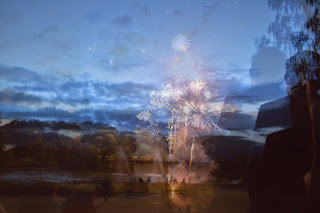Gyula-Halász which he then changed to Brassai was a Parisian photograoher born September 9th 1899 in Brassó. He felt very passionately about photographing cities at night and even wrote that 'photography allowed him to seize the Paris nigt and the beauty of the streets and gardens in rain and mist'. Although he focused on the streets and gardens he also photographed some of his artist friends including Salvador Dali, Pablo Picasso, Henri Matisse, Alberto Giacometti and many others. I am looking at his work because in my opinion his work is very representative of reflection as when he takes a picture of a river he always includes the reflection of the street lights in his photo. I think his ohotos are very effective and this is partially due to the use of black and white as it shows reflection very well.
In the background of this photo, there is a bridge with lots of lights over a river, in the foreground there is a silhouette of a tree branch. Although the tree branch is in front of the bridge, the bridge is the focal point of the image. This image shows reflection because the lights on the bridge are reflecting off of the river under the bridge. If someone was to look at this image, I believe that they would say reflection is shown in this image.
This image also shows reflection by lights on a bridge reflecting off of the water however in this image there is a silhouette of the eiffel tower in the background behind the bridge and this is effective because it emphasises brassais love for paris and also sets the scene.
This photo shows a street lit by street lights, this inage is more subtle at showing reflection than some of his other photos however there is a slight reflection of light off of the pavement. This picture may not be the best at representung reflection however I felt that although this was subtle, it was still an effective image.
This image shows a women walking down a street, however you cab see the women's reflection in the ground. This suggests tht maybe it was raining prios to taking this photo. This photo represents reflection in a different way to the other examples of brassais work however I think this is very effective.
Influence
Brassai's work influenced me because I found his use of black and white for every photograph very interesting. I also liked how within his images there was a variety of different formal elements being portrayed. I also found that Brassai's images were all very dark and found this similar to how i like to photograph within the studio. The image below is one of my photographs which I took whilst out on a walk, I took this for sense of journey however with a black and white filter I felt that this was very similar to Brassai's images. After looking at Brassai I took this image and noticed how the composition of the two images was very similar and this was slightly influenced by Brassai.
Summary
When I first looked at Brassai's work I found it very interesting and unusual however after looking at more photographers I have found that I do not like his work as much anymore. In my opinion I prefer some of the photographers who use more colour within their photos because they makes them more eye-catching.
Brassai's work influenced me because I found his use of black and white for every photograph very interesting. I also liked how within his images there was a variety of different formal elements being portrayed. I also found that Brassai's images were all very dark and found this similar to how i like to photograph within the studio. The image below is one of my photographs which I took whilst out on a walk, I took this for sense of journey however with a black and white filter I felt that this was very similar to Brassai's images. After looking at Brassai I took this image and noticed how the composition of the two images was very similar and this was slightly influenced by Brassai.
Summary
When I first looked at Brassai's work I found it very interesting and unusual however after looking at more photographers I have found that I do not like his work as much anymore. In my opinion I prefer some of the photographers who use more colour within their photos because they makes them more eye-catching.























































